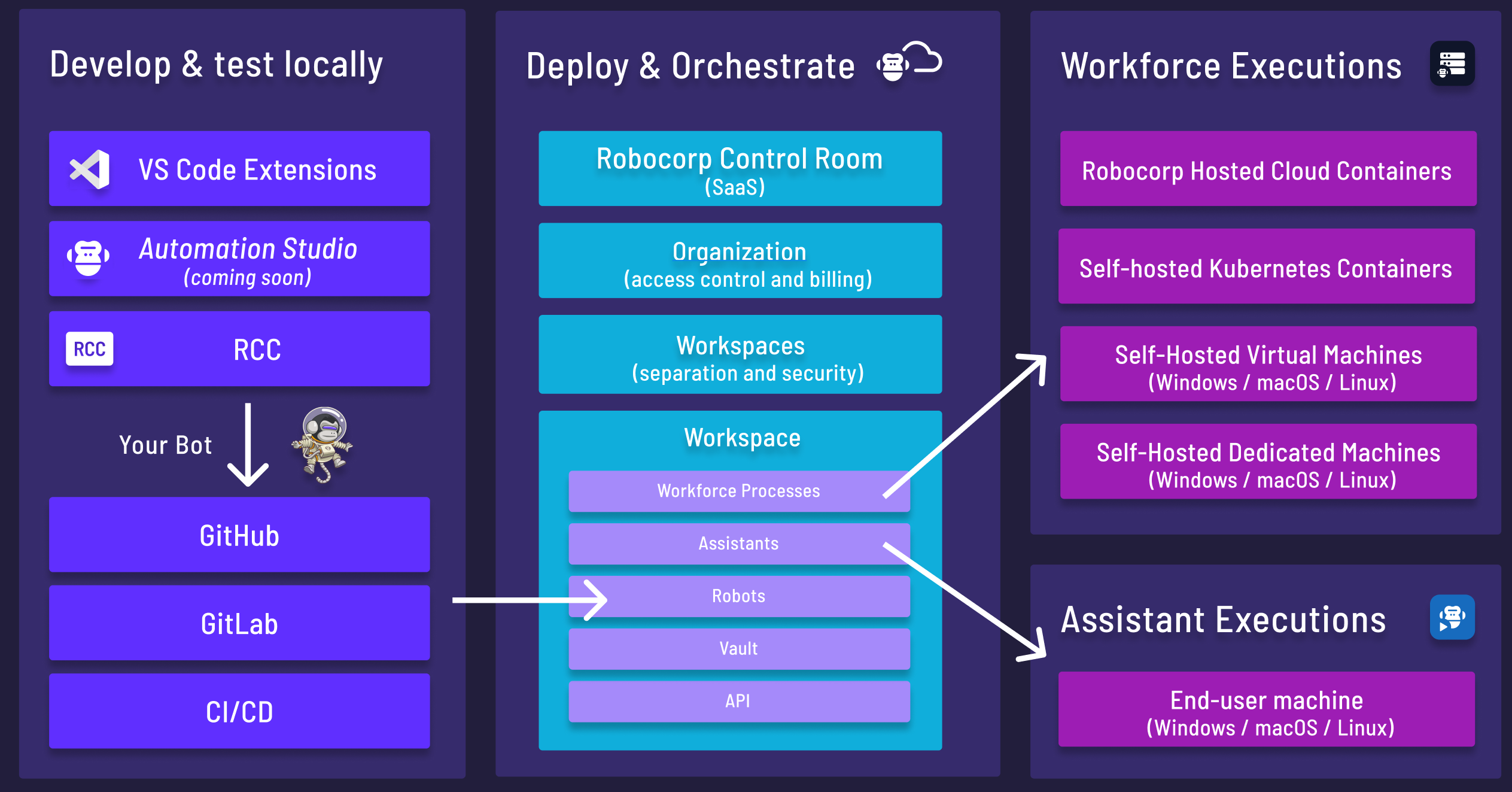Control Room
Robocorp Control Room is a convenient way to distribute, monitor and manage your automations in real-time across your organization from one central command.
Robocorp Control Room's key promise is to provide a secure, reliable, and scalable way to orchestrate software robots. It is an all-in-one orchestration solution, so you do not need to maintain and host your own servers, databases, or unattended workers.

The Control Room provides value to operations by providing features for many different needs, for example:
Efficient and scalable cloud infrastructure
- Always available Robocorp-Hosted Cloud Workers for one-click setup
- Dynamic worker parallelization that allows you to auto-scale your unattended processes up or down
- Cloud database and work item system enable scaling workloads, data integrations and robust exception handling.
Dashboards for tracking the performance of automations
- Status of all automated processes
- Metrics to track the business value of all automated processes
- Providing traceability to robot operation
Secure way to manage robots and data
- Workspaces to separate business functions or development and production
- Centralized distribution of robots
- Secure Vault to store secrets needed by the automated processes
Modern and best practices built-in development
- APIs to integrate with 3rd party applications
- Support for best practice software development workflows
- Version control integrations
Control Room provides value to operations by providing features for many different needs, for example:
- Dashboards to monitor your automations
- Organizations and Workspaces to separate user access and data
- APIs to integrate Cloud with 3rd party applications
- Centralized distribution of robots
- Management of unattended workers
- Secure Vault to store secrets needed in automated processes
- Storage of process operational data
- Providing traceability to Robot operation
- Providing extensive Metrics to track business value generation
Powerful integrations and Cloud scale enable unmatched flexibility and efficiency for all kinds of automation use cases. Using our Software Robot Platform, you can feel safe about your robots and data.
Control Room: Basic concepts and terminology
Overview
Control Room is set up in a hierarchical way. At the top, we find the Organizations, under which Workspaces are created, that contains Processes, which use Steps from Robots. Steps inside processes are then run by Unattended Workers. Processes in the same workspace have access to the same Vault. Steps in the same process can share information using the Work Item.
Let's look at these concepts one by one:
Organizations
Organizations group and provide access control and administrative features to workspaces and users. Users belonging to the same organization can collaborate on creating and maintaining software robots in shared workspaces. Users can belong to more than one organization and can create organizations as needed. Billing happens at the organization level. The best practice is to use organizations to represent companies (e.g. your company where you work could be one organization in the Control Room) or clients if you are an automation service provider.
Workspaces
When you register to Control Room, you get your own workspace. Workspaces are used to separate user access and data, which is a common use case when doing automation according to best practices and addressing common compliance requirements. All resources created for a workspace are specific to that workspace only and are not shared between other workspaces. For example Vault secrets and Unattended Workers are workspace-specific, which allows you to create isolated environments for Production, Development and different business units.
Robots
Robots in the Control Room represent the code that is written to automate things. You can import your robots into Control Room as zip files that follow the robot structure guidelines or use multiple version control integrations available. A robot can include more than one task, which can be assigned to process steps or used as Assistants. For example, you could create one robot that groups all the steps that work with one target system, for example, Excel.
Processes (unattended automation)
To run an unattended software robot in Control Room, you execute a Process. When creating a process, you will choose which process steps are executed, in which order, and by which unattended worker. Processes can be scheduled and triggered either manually in the Control Room UI or via an API. Processes use the work item system, which allows scaling of workloads and robust exception handling.
Work Item
Work items are used in processes to enable efficient, scalable and robust processing. One work item commonly represents one thing that is processed by the robots from the business process perspective, e.g. an order, a customer or an invoice number. During the execution, each step can freely read and update the data contained in the work item and create output work items for the next step. For more information about work items and how to use them, please see the Work Items page.
Assistant (attended automation)
Control Room can be used to centrally manage and distribute Assistants, which are a type of robot meant to be executed by the end user directly in Robocorp Assistant. The end user can work with the robot to complete tasks using forms and prompts. Assistants are intended to run simple automations, and processing work items is not supported.
Unattended Workers
The robots that Control Room controls are ultimately run by Unattended Workers. An unattended worker can be, for example, a Cloud Worker hosted by Robocorp (a Docker container), or a user-hosted unattended worker, running on a Windows, macOS, or Linux machine using different Worker setups.
One unattended worker executes one step run at a time in an isolated environment. The unattended worker creates the correct environment for the steps to be run successfully, wherever it is executed.
Vault
Vault provides a way to store credentials and other sensitive information inside the Control Room that your robot code can easily access and use. Vault secrets are tied to a specific workspace.